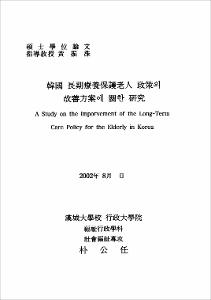韓國 長期療養保護老人 政策의 改善方案에 關한 硏究
- Files in This Item:
-
-
Download
 000000066112.pdf
기타 데이터 / 3.11 MB / Adobe PDF
000000066112.pdf
기타 데이터 / 3.11 MB / Adobe PDF
-
Items in Repository are protected by copyright, with all rights reserved, unless otherwise indicated.
 000000066112.pdf
기타 데이터 / 3.11 MB / Adobe PDF
000000066112.pdf
기타 데이터 / 3.11 MB / Adobe PDFItems in Repository are protected by copyright, with all rights reserved, unless otherwise indicated.